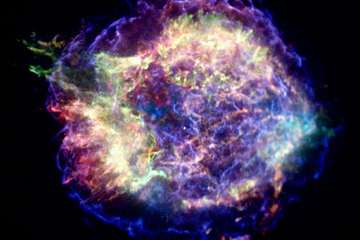April 16, 2013 report
Remnants of supernova explosion found in ancient magnetotactic bacteria

(Phys.org) —Back in 2004, German scientists discovered traces of supernova ejecta that had been deposited in the deep-sea ferromanganese crust of the pacific ocean. They dated the supernova event to 2.8 million years ago (Mya), using estimates from the decay of iron-60 radioisotope. They were also able to estimate the distance of the supernova event to 10 parsecs (pc) from our sun, based on the amount of iron-60 deposited. At the April 14th meeting of the American Physical Society, a Canadian scientist, Shawn Bishop, reported finding traces of iron-60 of supernova origin in the fossilized remains of a common bacteria. By accurately dating the sediment cores in which the samples were found, Bishop appears to have discovered the first biological signature of an ancient supernova event, and may even be able to link it to a specific exploding star.
Bishop analyzed sample cores from strata roughly 100,000 years apart within deposits from 1.7 to 3.3 Mya. Iron-60 is not a product of any processes occurring here on earth, so any supply of it can be assumed to from a non-terrestrial source. Bishop was able to extract out all the iron-60 of biological origin, and quantify it with a mass spectrometer. The amounts found were small, but they were enough to reliably date the sample to a period around 2.2 Mya. Other researchers, peripheral to the project, were then able to suggest a possible candidate star that dates to this period may lie in the Scorpius-Centaurus stellar association, roughly 130 pcs (424 light-years) from the sun.
Iron-60 has a half-life of 2.6 million years, and makes an ideal clock for dating deposits on this timescale. It undergoes beta decay to form cobalt-60. A likely source for the iron concentrations in the deep-sea cores could be magnetotactic bacteria. These creatures incorporate crystals of magnetite (Fe3O4) in the form of long chains inside specialized organelles called magnetosomes. These organelles are used to sense the earth's magnetic field and possibly navigate in response to it. Magnetite-containing bacteria are today usually found in transition zones where oxygen-rich waters meet anoxic waters.
These discoveries paint a dramatic scene of supernova explosions raining down radioactive debris on the ancient earth. These deposits then filtered through the water where they also got incorporated into various iron-sulfide reactions, or manganese nodules still mined today. Many people might remember Howard Hughes' Glomar Explorer project, and the dramatic CIA efforts to find the wreck of the Soviet K-129 nuclear submarine. Mining the iron-rich manganese nodules was the convenient alibi the Glomar explorer used while it searched for the secret sub. Exploration of the deep links between the earth and its cosmic neighbors will undoubtedly continue to give tremendous insight into events both here and beyond.
More information: Abstract: X8.00002 : Search for Supernova 60Fe in the Earth's Fossil Record, Bulletin of the American Physical Society, meetings.aps.org/Meeting/APR13/Event/192798
Approximately 2.8 Myr before the present our planet was subjected to the debris of a supernova explosion. The terrestrial proxy for this event was the discovery of live atoms of 60Fe in a deep-sea ferromanganese crust. The signature for this supernova event should also reside in magnetite (Fe3O4) magnetofossils produced by magnetotactic bacteria extant at the time of the Earth- supernova interaction, provided the bacteria preferentially uptake iron from fine-grained iron oxides and ferric hydroxides. Using empirically derived microfossil concentrations in a deep-sea drill core, we deduce a conservative estimate of the 60Fe fraction as 60Fe/Fe =3.6×10−15. This value sits comfortably within the sensitivity limit of present accelerator mass spectrometry (AMS) capabilities. This talk will detail the present status of our 60Fe AMS search in magnetofossils and (possibly) show our initial results.
via Nature News
© 2013 Phys.org



















